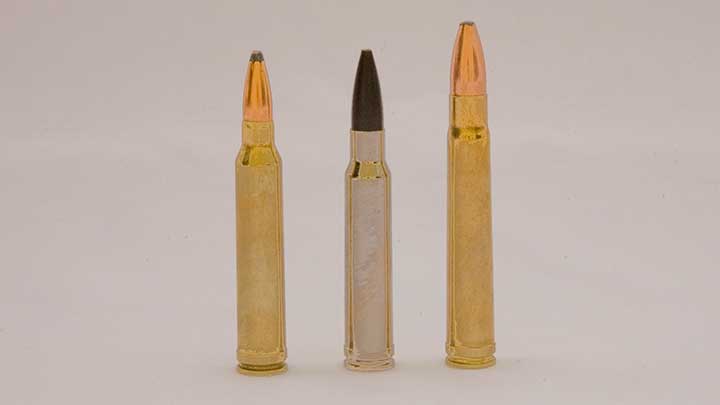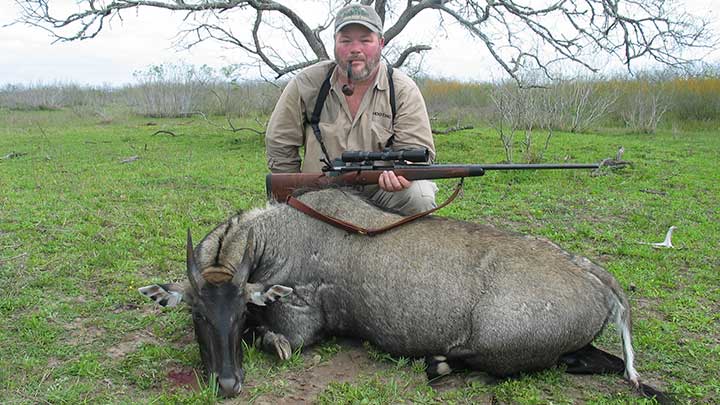
Around this time of year in my part of the country, a lot of folks start thinking about elk hunting. Elk are big and pretty tough cervids, and a lot of guys believe they need more power than a .270 Win. or .30-‘06 Sprg. in order to kill one. That’s not really true, but beliefs are often immovable. Among the power folks, the .338 Winchester Magnum is a popular choice.
Like many—perhaps most—cartridges, the .338 Win. Mag. has a lineage. In other words, it was not drafted from scratch by some designer; it came from a parent cartridge. The .458 Win. Mag., which originated from shortening the .375 H&H Mag. and brought to market in 1956, is the parent of the .338 Win. Mag. When it was introduced in 1958, the .338 Win. Mag. was only chambered in the Winchester Model 70 Alaskan. Its designers envisioned it as a cartridge for large animals like elk and moose, along with larger bears. To that end, it was and remains an effective and successful cartridge.
If the .33 caliber seems odd, it really isn’t. Europe, primarily England, had brought forth the .333 Jeffery in 1908. It was popular as a medium bore in Europe and Africa, featuring 250- and 300-gr. bullets at 0.333" diameter at 2,400 and 2,150 f.p.s., respectively. The 250 gr. loading used a hollow-point bullet that tended to fragment and come apart at close range, giving a bit of a bad reputation to the cartridge. When Winchester came out with the .33 Winchester Center Fire in 1902, they chose to make their .33-caliber bullets at 0.338".

The .33 WCF enjoyed a fair amount of popularity as a deer, elk and black bear round in the thick woods, more or less replicating the ballistics of the rimless .35 Remington. Later in the 1940s Charlie O’Neil, Elmer Keith and Don Hopkins experimented with .333 bullets in a .30-’06 Sprg. case, developing the .333 OKH cartridge in 1945. It later morphed into the .338-'06, a somewhat popular wildcat cartridge. The .333 OKH was a marked improvement over the .33 WCF, providing about an additional 500 f.p.s. to the 200-gr. bullet and pretty much replicating the ballistics of the .348 Win. in a rimless cartridge.
This rim and rimless interchange is due to late 19th and early 20th century technology. Because most lever-action rifles needed a rim to both headspace as well as feed from predominantly tubular magazines, rimmed cartridges like the .33 WCF and .348 Win. were created. Bolt action rifles are better and more reliably fed by rimless cartridges from box magazines. The bolt guns are capable of withstanding higher pressures, hence higher velocities, than lever guns.
So when Winchester wanted to modernize the medium bore, it looked to its .458 Win. Mag. It was a relatively simple matter to neck down the big bore, give it a 25-degree shoulder and load bullets from as light as the 160-grain Barnes to beefy 300-gr. bullets. The most popular weights are 210 and 225 gr. A 210-gr. Nosler Partition can be launched to 2,894 f.p.s. With a Sectional Density (SD) of 0.263 and a Ballistic Coefficient (BC) of 0.400 it compares favorably to the 180-gr. .308 bullet.
Launched from a .30-'06 Sprg. at similar velocity, the 180-gr. bullet will fall away from line of sight more than the 210-gr. bullet in a .338 Win. Mag. starting at about 160 yds. downrange. At 400 yds., the 210 gr. .338 Win. Mag. will have some 11" less drop than the 180 gr. .30-'06 Sprg. and have just shy of twice the energy. No doubt about it, the .338 Win. Mag. certainly thumps.
Of course, if it thumps more downrange, it will thump more at the shooter’s shoulder. That 180 gr. .30-'06 Sprg. will caress your shoulder with 28.19 ft.-lbs. of free recoil; the 210 gr. .338 Win. Mag. will give you 31.66 ft.-lbs. of love. It’s not a huge difference, but if you don’t handle recoil well the magnums are not for you.
My experience with the .338 Win. Mag. is that well-hit animals usually go down quickly and not-so-well-hit critters may be a problem. On the not-so-well-hit animals, they may not run as far as animals not-so-well hit with lighter cartridges. I once shot a bull elk at about 260 yds. with my .338 Win. Mag., and hit it in the paunch because the scope had gotten knocked out of alignment.

Fortunately, the bull stayed down long enough for me to make a correction with a finishing shot. A couple of weeks after that incident and after re-zeroing, I center-punched a woodland caribou at 350 yds. with the same rifle and load. That animal ran about 50 yds. before piling up. A few years later I put four 225-gr. Winchester FailSafes, a very hard and durable bullet, into the shoulder of a bull nilgai in a group you could cover with your hand, and it still took a couple of minutes before the animal collapsed. He didn’t go anywhere, but he took a lot of punishment.
The .338 Win. Mag. has been chambered in nearly any rifle intended for hunting. First, of course, was the aforementioned Model 70 Alaskan. Remington chambered the round in its Model 700 and still does. Its popularity is waning slightly as cartridges like the .338 Lapua have garnered shooters’ interest. In Alaska and the inter-mountain region, the .338 Win. Mag. remains a go-to cartridge for many who pursue large dangerous game.
As a plains-game rifle in Africa, the .338 Win. Mag. has a good reputation, but it lags behind the .375 H&H Magnum. Though it has plenty of power, far more than is necessary, there are quite a few pronghorn hunters who swear by the .338 Win. Mag.
For a 62-year-old cartridge, the .338 Win. Mag. has done pretty well. It never has benefited from being an American military cartridge, thus lacking cheap and readily available surplus ammo. Newer and more powerful upstarts post a mild threat to its market share. As a virtually exclusive sporting cartridge, it still remains a popular choice for those desiring more power. I doubt that the .338 Win. Mag. will be discarded anytime soon.





































